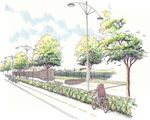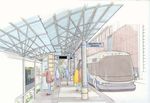Rapid Transit Backgrounder - City of Winnipeg
←
→
Page content transcription
If your browser does not render page correctly, please read the page content below
Rapid Transit Backgrounder
Moving Forward On Rapid Transit
The concept of a Rapid Transit System for Winnipeg has been debated for over 30
years. City Council and the Province of Manitoba have demonstrated commitment and
forward thinking for Winnipeg by including Rapid Transit in the City’s official plan — Plan
Winnipeg 2020 Vision.
What Is Rapid Transit?
Rapid Transit is leading edge public transportation that can move more people, more
quickly and create powerful solutions to many challenges our City faces. It can have a
positive impact on economic development, downtown revitalization, renewal of inner city
neighbourhoods and environmental stewardship. By embracing technological
advancements in transit, we can rejuvenate public interest and accelerate growth in our
transit system — an essential element of any major progressive city.
What Type Is Best For Winnipeg?
There are many types of Rapid Transit Systems -- guided rail systems such as subways
in Toronto and Montreal, Light Rail Transit (LRT) in Calgary and Edmonton, and
elevated LRT like the SkyTrain in Vancouver. Others are more flexible, non-rail systems
like the Transitway in Ottawa, and similar busway systems in Pittsburgh, Brisbane,
Adelaide, and several cities in Japan, Europe, and South America.
Guided rail systems work well in high-density corridors where many people live and work
within walking distance of the stations. However, in a low-density city like Winnipeg, a
more flexible, cost-effective approach to Rapid Transit is needed.
Bus Rapid Transit (BRT) combines the attractive features of a rail system with the
flexibility of a bus system to provide fast, convenient, comfortable transit service that
minimizes the need to transfer. BRT features include:
• Separate roadways called Busways -- exclusive to
transit -- that permit high-speed operation (up to 80
kph)
• Traffic signal priority for transit vehicles at intersections
• Fully developed Rapid Transit stations on Busways
• Real-time route and schedule information at stations
• Next Stop displays and enunciators on vehicles
• Modern, state-of-the art rubber-tired vehicles that
provide high-level comfort and passenger amenities
• High frequency, all day service-2-
How Does A Busway Work?
A Busway is a separate, transit-only
roadway that allows BRT vehicles to bypass
congestion and travel at high speed to
reduce travel time. Since BRT vehicles are
rubber-tired, they can operate both on and
off the Busway to provide very flexible
routes that minimize door-to-door travel
time. For example, a BRT route can
operate on streets in a neighbourhood to
pick up passengers near their residences
and then get on the Busway to travel at high
speed to downtown. Once downtown, BRT
vehicles can then use existing transit priority
measures, such as Diamond Lanes and the
Graham Transit Mall.
To enhance public safety, emergency
vehicles will also be able to use Busways.
Construction of recreation paths adjacent to
Busways is also planned.
Why A BRT System?
Compared to other systems, BRT offers advantages for a city of Winnipeg’s density:
• BRT route networks are very flexible and eliminate transfers.
• Busways are much more affordable to build – costing significantly less than an
equivalent LRT line.
• BRT operating costs are lower than those for a comparable LRT system in low
density corridors
• BRT systems are much easier to stage. As funding becomes available, a stage
can be built and immediately put into service.
• BRT systems provide the flexibility to transition to higher capacity systems if
demand increases significantly.
Many other cities have recognized these advantages and are planning to build BRT
systems. In Canada, Ottawa, Vancouver, and Quebec City have already implemented
BRT services. In addition to Winnipeg, Montreal, Gatineau, Toronto, Mississauga, York
Region, and GO Transit are planning to introduce new BRT systems over the next few
years.
In the United States, the Federal Transit Administration is funding BRT showcase
projects in 10 cities, including Boston, Cleveland, Miami, Las Vegas, Los Angeles, and
Honolulu.
In other parts of the world, BRT is used extensively. State-of-the-art systems are
operated in such diverse places as Curitiba (Brazil), Bogota (Columbia), Nagoya
(Japan), Adelaide and Brisbane (Australia), and in several European cities.-3-
What Kind Of Vehicles Will Be Used For BRT?
State-of-the-art, air-conditioned, rubber-tired coaches will be used to provide high-level
comfort and convenience for BRT passengers. These vehicles will travel on the
Busways as well as regular city streets.
BRT vehicles will be of a low floor design, with accommodation for mobility devices to
ensure that all citizens can enjoy easy access to Rapid Transit services.
New low emission electric hybrid technologies will be used initially with later conversion
to fuel cells when they become commercially viable.
Guidance systems that enable BRT vehicles to “dock” at stations, providing subway-like
level boarding, are also under consideration.
Intelligent Transportation System Technologies
Winnipeg’s BRT system will employ new ITS technologies to provide efficient, fast
operation and current information for passengers:
• Advanced bus communications system with automated vehicle location
• Traffic signal priority for BRT vehicles at intersections
• Real time schedule information displays at stations and in major activity centres
served by the BRT network
• On board “next stop” displays and enunciators-4- Where Will The Rapid Transit System Be Built? The long term, city-wide Rapid Transit System includes six “legs” or corridors, designed to increase speed and enhance public transit performance throughout Winnipeg.
-5- Benefits of a Rapid Transit System For Winnipeg The Need for Speed Research shows that a door-to-door travel time of 35 minutes or less makes travel by transit in Winnipeg attractive. Right now, less than half of the City’s population can travel downtown within this timeframe. With the addition of a Bus Rapid Transit System, 85% of the City’s population will be able to travel downtown in 35 minutes or less. Pluses for Passengers Reduced travel times, increased on-time reliability and a significant reduction in the need to transfer will add up to more convenient travel for transit passengers. Going Green Bus Rapid Transit will allow Winnipeg to play a key role in helping meet Canada’s commitment to reduce greenhouse gas (GHG) emissions. A Rapid Transit System in Winnipeg is an investment in a cleaner, greener environment. Public transit contributes less than one per cent of transportation-related emissions, compared to passenger vehicles that create about 30 per cent in urban areas. Building Business Local heavy construction, engineering and bus manufacturing industries will all benefit from the investment in Bus Rapid Transit. The initial construction investment is estimated to generate 775 person years of work in the engineering and construction industry alone. Suppliers to these major industries will also experience substantial spin- off growth. Up Side for Downtown Winnipeg’s Rapid Transit System will support new downtown developments like the True North Entertainment Complex, Red River College Princess Street Campus, the Canadian Museum for Human Rights at the Forks, the Millennium Library, and the new Manitoba Hydro Head Office. Smart Growth Rapid Transit in Winnipeg will set the stage for “Smart Growth” opportunities adjacent to the new BRT corridors. Cities like Ottawa, Calgary, Edmonton, Vancouver and Toronto have all experienced a trend of increased property values for both commercial and residential development along Rapid Transit corridors. Inner-city neighbourhoods can also realize similar benefits, which may increase property values, and encourage additional infill development. Smart development encourages more sustainable growth, building a better inner city for all citizens to enjoy.
-6- Safer Streets A Rapid Transit System will increase pedestrian activity, which in turn supports retail businesses and discourages crime. A safe, vibrant and successful downtown attracts people for shopping, entertainment, dining and personal business. On Our Way A Rapid Transit System for the City of Winnipeg offers many benefits for many groups. It supports economic development and downtown revitalization. It provides safe and reliable transportation for workers, students, shoppers and tourists. It offers a significant opportunity to help achieve our environmental commitments. Introducing a Bus Rapid Transit System that delivers superior speed and state-of-the-art technological advancements will dramatically improve public transportation in Winnipeg – benefiting the City as a whole, enhancing the image of our Province’s capital, and bringing Winnipeg up to speed with other major progressive Canadian cities.
You can also read


























































